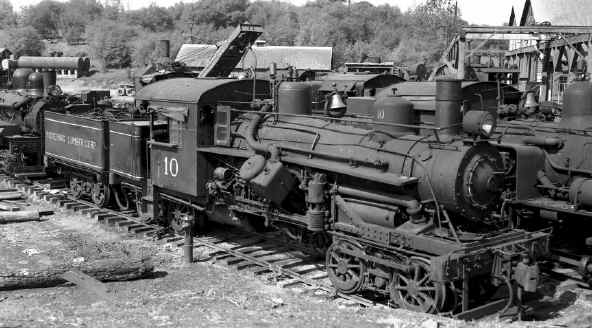Heisler #10: Geared Locomotive |
|
By the early 19th century there were 3 logging locomotive
manufacturers actively supplying geared locomotives to the steam loggers
across the U.S. The 3rd to
enter the market was the Heisler Locomotive Works of Erie, Pennsylvania.
Their geared engines with their unique "V-shaped"
cylinder arrangement were faster and more powerful than the comparable
Shay and Climax locomotives that were available at the time. The early geared engines were all of a 2-truck variety. These
had the boiler, cab, and fuel all mounted on 2 sets of geared drivers.
As the power needs of the loggers increased, both Shay and Climax
perfected a 3-truck machine where the fuel and boiler were over the
first 2 trucks and the water tender was mounted on a 3rd separate truck. This added weight gave the 3-truck models greater tractive
effort and range over the loggers railroads of the day. In 1912 an order came in from the Blue Jay Lumber Co, of
Raleigh, W. VA for a large and powerful Heisler locomotive. Heisler set out to design a 3-truck model that would work for
a logger. The result was
the #10 - "P.J. Lynch". She
was the only 78-ton Heisler ever constructed and was the very first
successful 3-truck Heisler
ever built. After she was
tested and run for a period of time, Heisler began building 3-truck
Heislers by the dozens. The
ultimate refinement of this design was the West Coast Special Heisler
that is represented by
Mount Rainier Scenic RR #91. The "P.J. Lynch" operated successfully for a
number of loggers in West Virginia when in 1922 she was sold by a dealer
to the Standard Lumber Co. of Standard California. While at Standard,
she was numbered #10. The crews dubbed her the "Sacred - Ox"
because she was the most powerful and easiest-to-run locomotive on the
railroad at the time. In the 1930's Standard Lumber Co. became the Pickering
Lumber Co. and #10 continued to pull trains of pine logs down from the
Sierras to the big Pickering Mill at Standard, CA. Diesels had taken over most of the runs by the late
1950's and #10 was retired in 1963 after 51 years of logging service.
She was shipped with 2 other Pickering engines to a scrap yard in
Stockton, CA where she sat until 1966.
At that time Gus Peterson of Klamath, CA was building a tourist
railroad on part of his mill - timber holdings in the California
Redwoods. Gus moved #10 to Klamath and by late 1967 she was
steaming with 2-8-2 #17 on The Klamath & Hoppow Valley RR. This operation continued until the nations gasoline crisis of
1973 closed the line for good. In
1982 #10 and #17 were purchased by the Mount Rainier Scenic RR.
#17 is now operating. #10 sits here at Elbe awaiting her own
restoration. She is a
reminder of the innovation of the early 20th Century. Specifications: This
78-ton geared locomotive was built by the Heisler Locomotive Works in
Erie, PA for the Blue jay Lumber Company of Raleigh, West Virginia:
Ownership
History:
Photographs and information courtesy of Martin E. Hansen |
| HOME | ||||
| Cams/Plating |
